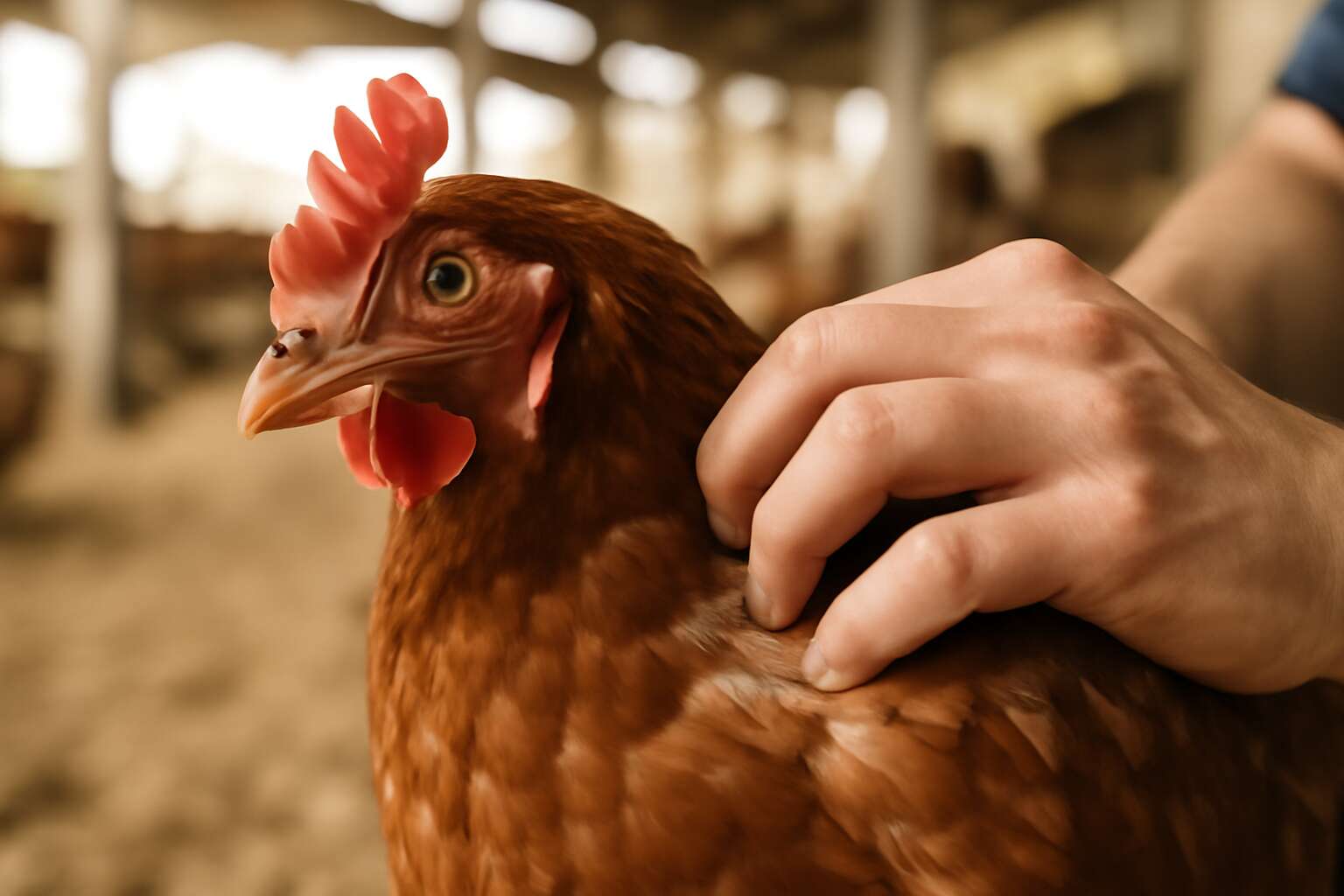Understanding Poultry Lice
What Are Poultry Lice? – Definition and common species
Poultry lice are tiny parasites that commonly infest chickens and other domestic birds, but their impact often extends beyond just the poultry. Understanding poultry lice is essential, especially when considering the question: can poultry lice affect humans? These lice, primarily belonging to species like Menacanthus and Menopon, are specialized for avian hosts. They are usually easy to spot in the poultry coops, crawling on feathers and skin.
While poultry lice are a nuisance for birds, their ability to affect humans is limited. However, in certain circumstances, they can cause skin irritation or allergic reactions in humans. This is especially true if someone works closely with infested birds or spends long hours in contaminated environments. It’s crucial to recognize common species and their behavior, as some lice might bite humans, leading to discomfort and potential secondary infections.
So, the real question remains: can poultry lice affect humans? The answer is generally no, but close contact with infested poultry can sometimes lead to skin irritation or other minor issues. Being aware of common species and their habits helps in managing and preventing infestations effectively.
Lifecycle and Behavior – How poultry lice live and reproduce
Poultry lice possess a surprisingly complex lifecycle that underpins their resilience and ability to infest avian hosts. These tiny parasites thrive in warm, humid environments—perfectly suited to the conditions of many South African poultry farms. Their life begins when adult lice lay eggs, known as nits, which cling tightly to feathers or skin. Within a week, these eggs hatch into nymphs—small, immature lice that are eager to feed and reproduce. The entire cycle—from egg to adult—can be completed in as little as two weeks under optimal conditions.
Understanding how poultry lice live and reproduce sheds light on why infestations can escalate rapidly if left unchecked. These insects are highly specialized, spending their entire life cycle on the host bird or in the immediate environment. They are adept at hiding in crevices, bedding, and coop corners, awaiting their next meal. While these behaviors serve the lice well, they also influence whether can poultry lice affect humans—a question that hinges on their lifecycle and habits.
Interestingly, the behavior of poultry lice in infested environments suggests that, although primarily adapted to avian hosts, they can sometimes bite humans—especially those working closely with poultry. This interaction is often accidental, occurring when the lice seek a blood meal or are forced off their hosts. The result can be skin irritation or allergic reactions, although these lice rarely establish permanent infestations in humans. Their lifecycle and behavior are central to understanding their potential impact beyond poultry farms, illustrating the delicate balance between parasites and hosts in shared environments.
Habitat and Infestation Signs – Where they are found and how to recognize an infestation
Poultry lice are sneaky little critters that prefer the company of chickens, but their habitat and infestation signs can tell a different story—especially for those wondering, can poultry lice affect humans? These parasites thrive in crevices, nesting boxes, and under the feathers of infested birds. When they’re not busy vampire-ing on poultry blood, they often hide in bedding, cracks in the coop, or in the corners of the poultry house, patiently waiting for their next meal. It’s a game of hide-and-seek that can escalate rapidly if not closely monitored.
Spotting an infestation isn’t rocket science, but it does require a keen eye. Look for signs such as:
- Excessive feather loss or damage
- Dark, pepper-like specks (their droppings) on feathers or bedding
- Restless, irritated chickens that scratch or peck at their skin
In some cases, poultry lice can bite humans—especially those who work closely with poultry—raising the question, can poultry lice affect humans? While they rarely establish long-term infestations in people, their bites can cause skin irritation and allergic reactions. So, whether you’re a farmer, a backyard enthusiast, or just curious, understanding the habitat and signs of infestation is crucial to prevent these tiny invaders from turning your poultry farm into a personal zoo of pests.
Can Poultry Lice Affect Humans?
Transmission Pathways – How lice transfer from poultry to humans
While poultry lice are primarily a nuisance for chickens and other birds, the question lingers—can poultry lice affect humans? The answer is nuanced. These tiny parasites are highly specialized for avian hosts, but under certain circumstances, they can make the leap to humans. Transmission pathways are often subtle, involving close contact with infested poultry or contaminated bedding, equipment, or clothing. When a person handles infected birds or visits a poultry farm with an active infestation, the chances of lice crawling onto human skin increase.
Though poultry lice are not known to live permanently on humans, their bites can cause irritation and discomfort. To understand how transmission occurs, consider that these lice are adept at grasping onto feathers and hair, transferring from poultry to humans through:
- Direct physical contact during handling or cleaning
- Contact with contaminated surfaces, such as cages or tools
- Exposure to infested bedding or feed
In the South African context, where poultry farming remains vital, awareness of these pathways is essential to prevent potential health issues. The key concern isn’t just the lice themselves but the possibility of secondary infections or allergic reactions stemming from bites. Therefore, understanding can poultry lice affect humans isn’t just a matter of curiosity—it’s vital for maintaining healthy, pest-free farms and safe communities.
Is There a Risk of Lice Infestation in Humans? – Differences between poultry lice and human lice
While poultry lice are primarily masters of their avian domain, the question of whether can poultry lice affect humans lingers like a faint whisper in the breeze. These tiny parasites, designed to cling to feathers and skin, rarely settle on human hosts permanently. Instead, they tend to be transient visitors, drawn by close contact with infested birds or contaminated surfaces. The risk of lice infestation in humans is real but generally limited to irritation and discomfort rather than a true infestation.
It’s important to distinguish poultry lice from their human counterparts. Unlike human lice, which have adapted specifically to dwell on our scalps or bodies, poultry lice are highly specialized for their avian hosts. They lack the biological tools to thrive on human skin long-term. However, their bites can cause allergic reactions or secondary infections, especially if scratching leads to open wounds. So, when pondering if can poultry lice affect humans, the answer hinges on the context—contact with infested poultry or contaminated materials can indeed lead to temporary nuisances, but not a pestilence of the same nature as human lice.
In environments where poultry farming is a cornerstone—such as South Africa—understanding these subtle distinctions helps prevent unnecessary alarm. The real concern is the potential for secondary health issues, which can arise from bites or allergic sensitivities. This nuanced understanding underscores why vigilance remains vital in managing poultry health and maintaining safe, pest-free communities.
Symptoms of Lice Infestation in Humans – Signs to watch for
While poultry lice are primarily a threat to birds, some wonder, can poultry lice affect humans? The truth is, their impact on people is usually minimal and fleeting. Most often, these tiny parasites cause irritation through bites rather than establishing a persistent infestation. If you notice scratching or redness after working closely with infested poultry, it might be a reaction to their bites, but it doesn’t mean a full-blown lice problem.
Signs to watch for include itchy, red welts or skin irritation, especially around areas where contact was most direct. In rare cases, bites can lead to secondary infections if scratching breaks the skin. People with sensitive skin or allergies may experience more pronounced reactions. It’s essential to remain vigilant—persistent discomfort or unusual skin changes should prompt a consultation with a healthcare professional. Remember, while can poultry lice affect humans, their primary concern remains for the poultry themselves, not human health.
Potential Health Complications – Possible health issues caused by lice in humans
The sinister whisper of poultry lice may evoke images of feathered foes lurking beneath the coop’s shadows, but can poultry lice affect humans in a way that threatens health? While these tiny parasites are primarily an affliction of birds, their potential impact on humans is often understated yet worth understanding. Most encounters result in fleeting irritation rather than a full-blown infestation, yet the possibility exists for more insidious health issues to emerge.
In rare instances, bites from poultry lice can lead to secondary infections, particularly if scratching breaks the skin’s fragile barrier. For individuals with sensitive skin or allergies, the reactions might be more pronounced—manifesting as inflamed, itchy welts that linger long after contact. Such symptoms serve as a stark reminder that, though poultry lice are not true human lice, they can still cast a shadow of discomfort. It is crucial to monitor any persistent skin changes that could indicate an adverse reaction, especially after handling infested poultry or contaminated bedding.
Understanding the potential health complications caused by lice in humans emphasizes that, despite their primary target being poultry, these parasites are not entirely benign to humans.
- Secondary bacterial infections from scratching
- Allergic skin reactions
- Potential for dermatitis or rashes
can all stem from bites or contact with infested environments. Vigilance remains our best defense—because in the murky world of parasites, even the smallest threat warrants respect and careful observation.
Precautions and Prevention
Good Poultry Management Practices – Maintaining healthy and lice-free poultry
Keeping poultry healthy is more than just a matter of good practice—it’s a vital safeguard for human well-being. While many farmers understand the importance of controlling poultry lice to protect their flocks, few realize that can poultry lice affect humans as well. These tiny parasites thrive on chickens, but their reach can extend beyond the coop if proper precautions aren’t taken. The key lies in maintaining rigorous hygiene standards and vigilant monitoring.
Implementing good poultry management practices can significantly reduce the risk of lice transmission. Regular cleaning of coops, bedding, and equipment disrupts lice habitats and prevents infestations from spiraling out of control. Additionally, inspecting birds weekly for signs of lice—such as feather loss or irritation—can catch problems early. To bolster defenses, some farmers use natural deterrents like diatomaceous earth or approved insecticides, always following safety guidelines to avoid any health hazards.
Remember, a healthy, lice-free poultry environment not only benefits the chickens but also protects the humans who care for them. Understanding the potential pathways of transmission and staying proactive with management practices ensures that can poultry lice affect humans remains a concern of the past. After all, safeguarding the health of your flock is ultimately an act of caring for everyone involved—farmers, families, and communities alike.
Personal Protective Measures – Protective clothing and hygiene tips
Understanding how to prevent the transmission of poultry lice from chickens to humans is essential for every farm owner and caregiver. The key to minimizing risk lies in rigorous personal protective measures. Wearing durable gloves and long-sleeved clothing while handling infested birds or cleaning coops creates a vital barrier against these tiny parasites. It’s an effective way to stop lice from hitching a ride onto your skin or clothing.
Hygiene plays an equally crucial role. Always wash your hands thoroughly with soap and water after working with poultry or cleaning their environment. Maintaining clean clothing—preferably dedicated work wear—reduces the chance of transferring lice to your home or family members. For added protection, some farmers opt for disposable coveralls, especially during intensive infestation periods. Remember, a vigilant approach to personal hygiene and protective clothing is your best defense against the question—can poultry lice affect humans? The answer is yes, but proper precautions make all the difference in keeping both your flock and your health secure.
Preventing Cross-Contamination – Keeping poultry and humans safe
Preventing cross-contamination in poultry farming is the linchpin of safeguarding both your flock and your health. The question of can poultry lice affect humans often lingers in the minds of conscientious farmers. The truth is, these tiny parasites are adept hitchhikers, capable of transferring from infested birds onto clothing, equipment, and even your skin. Vigilant hygiene and strategic precautions are essential to break this transmission chain.
Implementing a layered approach to prevention can dramatically reduce risks. Regularly disinfect tools and footwear, and designate specific clothing for farm work—preferably disposable coveralls during peak infestation periods. To further bolster defenses, some farmers in South Africa opt for a routine of thorough cleaning and inspection, focusing on high-risk areas like coops and nesting sites. Remember, maintaining strict hygiene doesn’t just protect your poultry; it’s a vital barrier against potential health risks associated with poultry lice, including the elusive question—can poultry lice affect humans?
In environments where poultry lice are present, understanding their transmission pathways is crucial. They are particularly skilled at hiding in crevices and bedding, only to emerge when humans handle infested birds or disturb their habitat. To prevent this, an ordered, methodical cleaning schedule can be your most effective tool. Here’s a quick overview:
- Wash and disinfect hands and arms thoroughly after contact with poultry or contaminated surfaces.
- Keep work clothing separate from household attire to prevent transfer.
- Ensure proper ventilation and regular pest control measures to minimize lice populations.
By adopting these measures, you create a protective barrier that minimizes the chance of lice crossing from poultry to humans. After all, awareness and consistency are your best allies in this ongoing battle against potential health hazards—because in the intricate dance of farm management, understanding can be the difference between thriving poultry and unwelcome parasites.
Treatment Options for Lice Infestations
Treating Poultry Infestations – Effective lice control in poultry
Effective treatment options are essential when dealing with poultry lice infestations. While poultry lice primarily target birds, questions often arise about whether can poultry lice affect humans. Fortunately, in most cases, poultry lice are species-specific and do not directly infest humans. However, they can cause discomfort and secondary skin irritations if they come into contact with human skin.
To control and eradicate lice from poultry, integrated approaches work best. Treatments such as topical insecticides, dusting powders, and environmentally safe sprays can significantly reduce lice populations. Regular cleaning of poultry housing and replacing bedding also disrupts the lice lifecycle.
Some farms also utilize natural remedies like diatomaceous earth, which can be sprinkled in nesting areas and on birds. It’s vital to monitor for signs of infestation and act swiftly. Remember, maintaining good poultry management practices helps prevent infestations and minimizes any potential risk to humans—especially since can poultry lice affect humans in rare cases when close contact occurs.
Managing Human Exposure – How to treat lice in humans if infected
When pondering the question of can poultry lice affect humans, many are surprised to learn that these tiny pests are predominantly species-specific. While their primary target remains the feathered inhabitants of farms and backyards, occasional encounters with human skin are possible, especially in cases of close contact with infested poultry. In such rare instances, humans might experience mild discomfort or skin irritations, but these lice are not known to establish permanent infestations on people.
Managing human exposure to poultry lice involves diligent hygiene and protective measures. If an individual suspects they have been affected, treatment options for lice in humans are straightforward and effective. Over-the-counter remedies, such as medicated shampoos containing permethrin or pyrethrin, can swiftly eradicate lice. It’s also wise to use fine-tooth combs to meticulously remove lice and nits from hair and clothing. Remember, early intervention is key to preventing any secondary skin complications or further spread.
- Wash all clothing, bedding, and towels in hot water to eliminate any lingering lice or eggs.
- Vacuum furniture and carpets thoroughly to remove potential lice habitats.
- Apply topical treatments as directed, and avoid sharing personal items like combs, hats, or towels.
By adopting these simple yet effective measures, individuals can manage and treat lice infestations in humans, reducing the risk of prolonged discomfort and secondary infections. While can poultry lice affect humans in rare cases, proper sanitation and protective practices remain the best defense—turning potential pest encounters into mere fleeting moments rather than prolonged pestilence.
When to Seek Medical Advice – Signs that require professional intervention
While poultry lice are primarily a concern for birds, many wonder, can poultry lice affect humans? The answer is usually no. Poultry lice tend to be species-specific, targeting chickens and other poultry. However, close contact with infested birds may lead to temporary skin irritation or mild discomfort in people. These lice rarely establish permanent infestations on humans, but vigilance remains important.
If you suspect lice in humans, treatment options are effective and straightforward. Over-the-counter medicated shampoos containing permethrin or pyrethrin can eliminate lice quickly. Combining these with meticulous combing to remove lice and nits ensures thorough eradication. In some cases, washing all clothing, bedding, and towels in hot water is necessary to prevent re-infestation.
Seek medical advice if symptoms persist, worsen, or if secondary skin infections develop. Signs that require professional intervention include intense itching, rashes, or persistent skin redness. Remember, early treatment helps prevent secondary infections and reduces the risk of further spread. While can poultry lice affect humans is rare, proper hygiene and prompt action are your best defenses against lingering pests.
Myths and Facts About Poultry Lice and Human Health
Common Misconceptions – Debunking myths
Amidst the rural symphony of clucking hens and rustling feathers, a lingering question persists: can poultry lice affect humans? Many believe these tiny invaders are confined solely to the poultry realm, but myth and misconception often dance in tandem. Some sinister tales suggest that lice from chickens can leap onto human hosts, causing a cascade of health concerns. Yet, the reality is more nuanced. Poultry lice are specialist pests—adapted to their avian hosts, not human flesh. The common misconception is that these parasites can easily transfer and thrive on humans, but this is a dangerous oversimplification.
In truth, poultry lice and human lice are distinct entities, each with unique biological needs. While poultry lice may cling stubbornly to their feathered hosts, they rarely pose a direct threat to human health. The myth that poultry lice can affect humans often fuels unnecessary panic. Conversely, facts reveal that proper poultry management and hygiene significantly diminish any potential risk. Understanding these distinctions helps demystify the fears surrounding poultry lice and reassures poultry owners that, with diligent care, the threat remains minimal. The question—can poultry lice affect humans—is better answered with knowledge and clarity, dispelling myths and highlighting facts to keep both poultry and humans safe.
Scientific Evidence – What research says about poultry lice affecting humans
Scientific research paints a clear picture: poultry lice are highly specialized parasites, with a penchant for feathered friends rather than humans. Despite some urban legends suggesting these tiny pests could leap from a chicken coop to a human scalp, the evidence tells a different story. Poultry lice are biologically wired to thrive on birds, not human hosts, making the notion that they can affect humans more myth than fact.
In fact, there is no documented case of poultry lice causing persistent infestations or health issues in humans. These parasites lack the necessary adaptations to survive on human skin or hair. Instead, what we often see are poultry lice causing discomfort in chickens—feather loss, itching, and stress—while humans remain safe from their clutches. This myth-busting fact reassures poultry owners that maintaining good hygiene and proper management effectively minimizes any risk of cross-species transmission.
To put it simply, can poultry lice affect humans? The scientific consensus suggests not. Poultry lice are a bird-only affair, and understanding this distinction is key to dispelling unnecessary fears. So, while the thought of tiny parasites crawling onto human flesh might make for good horror stories, the reality remains rooted in biology: poultry lice prefer their avian hosts, not ours.
Resources and Support
Veterinary and Medical Guidance – Where to find expert help
When the shadow of poultry lice cast its subtle menace over farms and homesteads, the question often whispers in the wind—can poultry lice affect humans? The answer, nuanced and layered like the intricate feathers of a bird, reveals that while poultry lice are primarily a pest of poultry, their potential to impact human health warrants careful attention. For those seeking guidance, expert resources are a beacon in the fog—veterinary and medical professionals who understand the delicate dance between pests and people.
In South Africa, where poultry farming is woven into the fabric of rural life, finding reliable support is crucial. Clinics specializing in zoonotic diseases or veterinary practices familiar with lice infestations often serve as the first line of defense. Additionally, government agricultural departments and local extension services provide invaluable insights and support for managing infestations effectively. Remember, early consultation with a veterinarian or healthcare provider can make all the difference, especially if concerns about the potential health effects of poultry lice on humans arise.
Educational Resources – Further reading and trusted websites
When navigating the shadowy realm of poultry infestations, knowledge becomes our most potent shield. For those eager to deepen their understanding, a treasure trove of educational resources awaits. Trusted websites such as the South African Department of Agriculture or reputable veterinary associations offer detailed insights into can poultry lice affect humans. These platforms provide up-to-date research, prevention strategies, and expert advice, ensuring farmers and homeowners are well-armed against potential health concerns.
Further reading can uncover the nuances of lice behavior and transmission, dispelling myths and clarifying real risks. Books, scholarly articles, and official guidelines serve as lanterns guiding responsible poultry management and human safety. By engaging with these trusted sources, you can stay informed about the latest scientific evidence on poultry lice and their impact on human health, fostering a safer environment for both poultry and people.




0 Comments